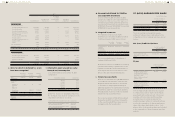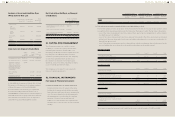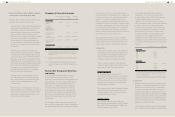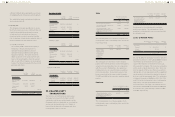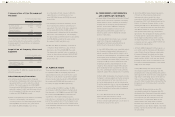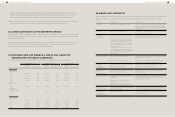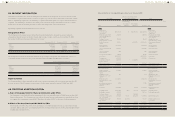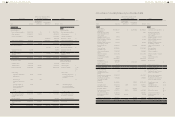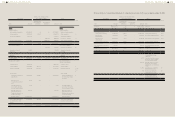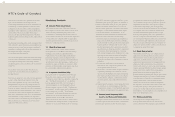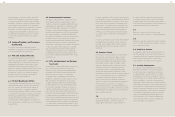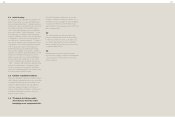HTC 2013 Annual Report Download - page 157
Download and view the complete annual report
Please find page 157 of the 2013 HTC annual report below. You can navigate through the pages in the report by either clicking on the pages listed below, or by using the keyword search tool below to find specific information within the annual report.
FINANCIAL INFORMATION FINANCIAL INFORMATION
310 311
of investment. Thus, as of January 1 and
December 31, 2012, the reclassification
adjustment resulted in decreases of
NT$25,474,750 thousand and NT$2,911,924
thousand in "cash and cash equivalents" and
increases by the same amounts in "other
current financial assets."
b) Under ROC GAAP, a deferred income tax asset
or liability should be classified as current or
noncurrent in accordance with the classification
of the related asset or liability for financial
reporting. However, a deferred income tax
asset or liability that is not related to an asset or
liability for financial reporting should be classified
as current or noncurrent on the basis of the
expected length of time before it is realized or
settled. By contrast, under IFRSs, a deferred
income tax asset or liability is always classified as
noncurrent. Thus, as of January 1 and December
31, 2012, the reclassification adjustment resulted
in decreases of NT$2,246,196 thousand and
NT$3,530,215 thousand in "deferred income
tax asset - current" and increases by the same
amounts in "deferred income tax assets - non-
current."
Under ROC GAAP, deferred tax assets are
recognized in full but are reduced by a
valuation allowance account if there is evidence
showing that a portion of or all the deferred
tax assets will not be realized. However, under
IFRSs, an entity recognizes only to the extent
that it is highly probable that taxable profits
will be available against which the deferred tax
assets can be used; thus, a valuation allowance
account is not used. Thus, as of January 1
and December 31, 2012, the reclassification
adjustment resulted in decreases of
NT$11,132,656 thousand and NT$6,445,409
thousand in "deferred income tax assets"
and in the valuation allowance account. Also,
as of January 1 and December 31, 2012, the
reclassification adjustment resulted in increases
of NT$340,261 thousand and NT$647,936
thousand in "deferred income tax assets" and
"deferred income tax liabilities".
4) Optional exemptions from IFRS 1
Under IFRS 1, an entity that adopts IFRS for the
first time should apply all IFRSs in preparing
financial statements and should make adjustments
retrospectively; however, the entity may select to
use certain optional exemptions and mandatory
exemptions stated in IFRS 1. The main optional
exemptions the Company adopted were as follows:
a) Business combinations
The Company elected not to apply IFRS 3
- Business Combination retrospectively to
business combinations that occurred before
the date of transition to IFRSs. Thus, in the
opening balance sheet, the amount of goodwill
generated from past business combinations
remains the same as that shown under ROC
GAAP as of December 31, 2011.
b) Goodwill arising from business combinations
and fair value adjustments
In accordance with IAS 21 - "The Effects of
Changes in Foreign Exchange Rates", any
goodwill and any fair value adjustment to the
carrying amounts of assets and liabilities arising
on the acquisition of a foreign operation should
be treated as assets and liabilities of the foreign
operation. Thus, goodwill and those fair value
adjustments should be expressed in the foreign
operation's functional currency and should be
translated at the closing rate at the end of the
reporting period. The Company elected not
to apply IAS 21 retrospectively to goodwill and
those fair value adjustments arising from business
combinations that occurred before the date of
transition to IFRSs. Thus, goodwill and fair value
adjustments that occurred before the date of
transition to IFRSs are expressed in New Taiwan
dollars using the historical exchange rates.
c) Share-based payment transactions
The Company elected to use the exemption
from the retrospective application of IFRS 2 -
"Share-based Payment" to all equity instruments
that were granted and vested before the date
of transition to IFRSs.
c) Under ROC GAAP, deferred income tax
assets or liabilities from intergroup sales are
recognized for the change in tax basis using
the tax rate of ROC. However, under IFRSs,
the buyer's tax rates are used instead. Thus,
the IFRS adjustment as of January 1, 2012
resulted in increases of NT$58,000 thousand
each in "deferred income tax assets" and
"accumulated earnings." In addition, the
evaluation adjustment made on December
31, 2012 resulted in increases of NT$83,000
thousand in "deferred income tax assets" and
in "accumulated earnings" and a decrease in
"income tax" by NT$25,000 thousand.
d) Under IFRS 1, the Company elected to
recognize all cumulative actuarial gains
and losses relating to employee benefits at
the date of transition to IFRSs. Thus, as of
January 1, 2012, the IFRS adjustment resulted
in a decrease of NT$83,687 thousand in
"accumulated earnings" due to decreases in
"deferred pension cost" by NT$342 thousand,
"defined benefit assets" by NT$83,052
thousand and "net loss not recognized as
pension cost" by NT$293 thousand.
As of December 31, 2012, the IFRS adjustment
resulted in a decrease in "accumulated
earnings" by NT$86,417 thousand due to
decreases in "deferred pension cost" by
NT$269 thousand, "defined benefit assets"
by NT$86,716 thousand and "net loss not
recognized as pension cost" by NT$347
thousand and increase in "deferred income tax
assets" by NT$915 thousand. In addition, this
adjustment resulted in decreases in "cost of
revenues" by NT$473 thousand, "selling and
marketing expenses" by NT$526 thousand,
"general and administrative expenses"
by NT$193 thousand and "research and
developing expenses" by NT$545 thousand.
e) Under ROC GAAP, if an obligation is probable
(i.e., likely to occur) and the amount could be
reasonably estimated, it is a contingent liability
and should be accrued for, but under which
d) Employee benefits
The Company elected to recognize all
cumulative actuarial gains and losses on
employee benefits in accumulated earnings at
the date of transition to IFRSs.
e) Accumulated balances of exchange
differences resulting from translating the
financial statements of a foreign operation
The Company elected to reset the
accumulated balances of exchange
differences resulting from translating the
financial statements of a foreign operation to
zero at the date of transition to IFRSs, and the
reversal has been used to offset accumulated
earnings as of December 31, 2011. Thus, the
gain or loss on any subsequent disposal of
foreign operations should exclude translation
differences that arose before the date of
transition to IFRSs.
5) Explanations of significant reconciling items in
the transition to IFRSs
Material differences between the accounting
policies under ROC GAAP and the accounting
policies adopted under IFRSs were as follows:
a) Under ROC GAAP, the term "cash" used in
the financial statements includes cash on
hand, demand deposits, check deposits, time
deposits that are cancellable but without any
loss of principal and negotiable certificates
of deposit that are readily salable without
any loss of principal. However, under IFRSs,
cash equivalents are short-term, highly liquid
investments that are both readily convertible
to known amounts of cash and so near their
maturity that they present insignificant risk
of changes in value. An investment normally
qualifies as a cash equivalent only when it has
a short maturity of three months or less from
the date of acquisition. Some certificates of
deposit the Company held had maturity of
more than 3 months from the date


